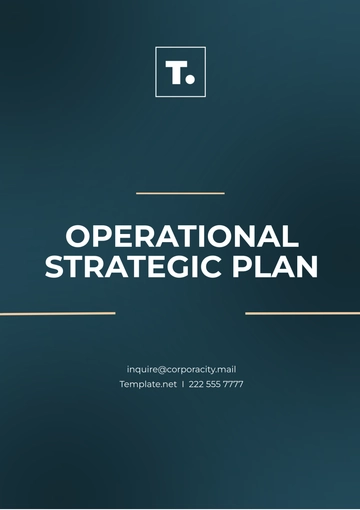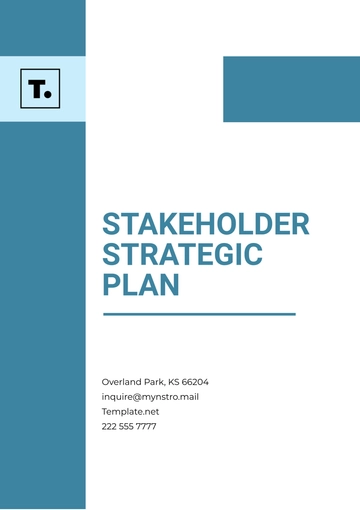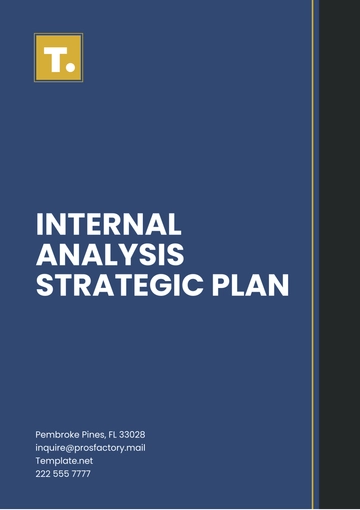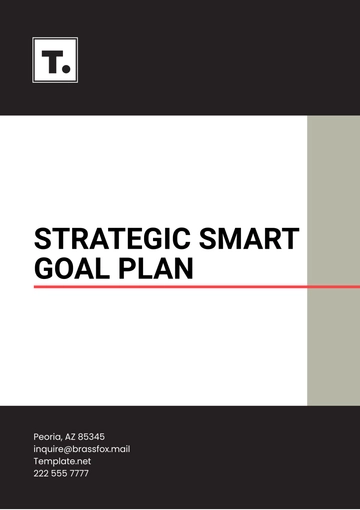Free Strategic Plan

[Your Company Name] Strategic Plan: 2050–2055
I. Executive Summary
This strategic plan outlines an ambitious, forward-looking approach to achieve transformative growth and sustainable impact for [Your Company Name] from 2050 to 2055. This document defines our long-term vision, mission, and strategic goals and provides a roadmap to achieve key milestones. Emphasizing innovation, ethical leadership, and responsiveness to global trends, this plan also includes financial projections and measurable indicators to ensure accountability and adaptability in an evolving market landscape.
II. Mission and Vision Statements
A. Vision Statement
Our vision is to be a globally recognized leader in sustainable technology solutions by 2055, setting benchmarks for environmental stewardship, innovation, and societal impact. We aim to influence industry standards while becoming a top choice for customers worldwide.
B. Mission Statement
Our mission is to create cutting-edge, eco-friendly products and services that address real-world challenges, enhancing the quality of life while prioritizing ethical practices and community welfare. We are committed to fostering a culture of integrity, inclusivity, and continuous learning.
III. Goals and Objectives
A. Short-term Goals (2050-2052)
Increase customer satisfaction by 20% within the first year by improving support services and expanding personalized product offerings.
Launch the AI-powered “EcoSmart” product line by Q3 of 2051, targeting energy efficiency and smart home integration.
Achieve a 15% reduction in operational costs through automation and digital transformation by the end of 2052.
B. Long-term Objectives (2050-2055)
Expand our market presence in Asia-Pacific and Latin America to become one of the top three competitors in sustainable technology solutions by 2055.
Reach $2 billion in annual revenue by the end of 2055 through strategic partnerships, international expansion, and product innovation.
Position [Your Company Name] as a leader in carbon-neutral operations, achieving net-zero emissions across our supply chain by 2053.
IV. Strategic Analysis
A. SWOT Analysis
Strengths
Established a reputation for innovation and quality.
Strong R&D capabilities focused on sustainable solutions.
Weaknesses
Limited market presence in emerging regions.
High dependency on traditional manufacturing processes.
Opportunities
Growing global demand for eco-friendly technology.
Increasing consumer preference for sustainable brands.
Threats
Intensifying competition in the sustainable technology market.
Regulatory changes impacting production and distribution practices.
B. Market Analysis
Global market trends indicate rising demand for sustainable technology solutions, with significant growth projected in renewable energy, water conservation technologies, and smart urban infrastructure. Competitors are also investing in green innovations, presenting both challenges and opportunities. Our strategic initiatives will leverage digital advancements and data analytics to better understand and anticipate customer needs, positioning [Your Company Name] for substantial growth.
V. Action Plans and Initiatives
A. Marketing & Sales Strategies
Execute targeted digital marketing campaigns that focus on eco-conscious consumer segments and highlight our unique value propositions.
Expand our social media presence and invest in influencer partnerships to build brand credibility in untapped markets.
B. Product Development
Establish a dedicated R&D unit for sustainable innovations, with a budget to explore renewable material usage and recycling initiatives.
Develop a new “Green Tech” series of products focused on minimal environmental impact, starting with renewable energy storage solutions in 2051.
C. Operational Efficiency
Implement an AI-driven inventory management system to reduce waste and optimize supply chain efficiency.
Introduce robotic process automation (RPA) to streamline repetitive tasks, lowering labor costs and increasing productivity across departments.
VI. Performance Metrics
Key Performance Indicators (KPIs) will guide our progress across various areas:
Market Penetration: Achieve a 10% increase in market share across targeted regions by 2053.
Customer Acquisition and Retention: Increase customer retention rates to 85% through enhanced service offerings.
Operational Cost Reductions: Track cost savings from automation and digital transformation, targeting a 15% reduction by 2052.
Environmental Impact: Reduce carbon emissions by 10% annually, aiming for full carbon neutrality by 2053.
VII. Financial Plan
A. Budget Allocation
Allocate 40% of the annual budget to R&D and sustainable product innovation, with a focus on renewable energy solutions.
Designate 25% to marketing and customer engagement initiatives, especially in high-growth markets.
Reserve 20% for digital infrastructure upgrades and process automation to enhance operational efficiency.
B. Revenue Projections
Based on market growth projections and our strategic initiatives, [Your Company Name] anticipates a steady increase in revenue over the next five years:
2051: $1.2 billion
2053: $1.6 billion
2055: $2 billion
These figures account for our expansion into new regions and the successful launch of high-demand products.
VIII. Monitoring and Evaluation
A. Progress Assessment
Schedule biannual reviews to assess the progress of each department against KPIs and adjust strategies as needed.
Conduct an annual review involving all stakeholders to evaluate overall strategic alignment, assess successes, and identify areas for improvement.
B. Feedback Mechanism
Establish channels for continuous feedback from customers, employees, and partners, ensuring our strategic plan remains adaptive and responsive to changing market conditions.
Implement quarterly surveys and focus groups to gather insights and refine our approach, enhancing stakeholder engagement and satisfaction.
- 100% Customizable, free editor
- Access 1 Million+ Templates, photo’s & graphics
- Download or share as a template
- Click and replace photos, graphics, text, backgrounds
- Resize, crop, AI write & more
- Access advanced editor
Design your success with our comprehensive Strategic Plan Template from Template.net. This customizable tool helps you set clear objectives, track progress, and streamline your organization’s vision. Fully editable in our AI Editor Tool, you can tailor the plan to meet your needs. Perfect for businesses, nonprofits, and more, this template allows you to easily modify sections, update strategies, and adjust goals as necessary.





























